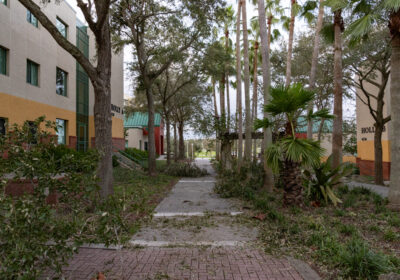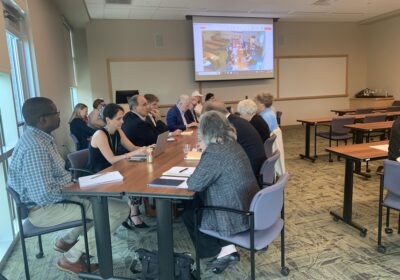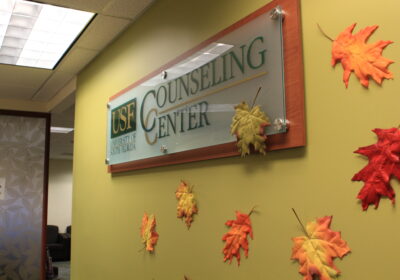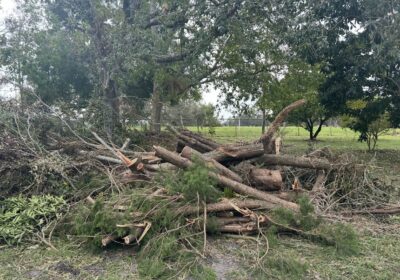IBL hosts African Art Exhibit, features donated pieces
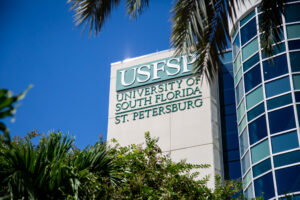
The African Art Exhibit, located at Harbor Hall on the St. Pete Campus, hosted by the Institute on Black Life (IBL), opened Jan. 31 and is free and open to the public until Feb. 11. Pieces in the collection were donated by Michael Orlosky, a member of the advisory board at the College of Public Health, and the Contemporary Art Museum at the Tampa campus.
As a donor and a sponsor, Orlosky had a large part in the creation of this exhibit. Of the 32 pieces featured, he estimated that he donated about two thirds of them.
Orlosky collected these pieces while in the Ivory Coast during the summer of 1972. His uncle owned a large international construction company and received a contract to build and open a sugar refinery and to assist in building a plantation there. This provided him with the opportunity to go and set up the office.
As a recent high school graduate in the fall of 1972 who had never been out of the country at the time, traveling to the Ivory Coast provided him with new experiences that gave him greater cultural understanding.
“Some things immediately struck me. First of all, I’m white. To suddenly be in a country where 98% are African and Black, I was very consciously aware of my being a minority,” Orlosky said.
“Second, although I had studied French, I was far from fluent. I had an appreciation for not only being a minority, but also not speaking the native language that well, trying to do business there [and] trying to get along with people.”
Abidjan, the capital at the time, is where Orlosky said he spent most of his time but had to travel about 250 miles north of the city to get to the construction site of the sugar refinery.
The city was very modern and populous, but traveling outside of its borders revealed lower-cost housing and buildings such as mud huts with thatched roofs, according to Orlosky.
Orlosky said he traveled through various forms of transportation available to him while in the Ivory Coast.
“I did it by car a couple of times and I did it by train once,” he said. “That’s how I was able to get around the country and see the rest of it.”
At the end of the summer, he said he was able to travel around the country and see the art and lifestyle of the tribes spread out throughout the Ivory Coast.
“There’s over 60 different tribal groups in the country,” Orlosky said. “As I traveled around, I got to know a little bit about each of them.”
While visiting these tribes, he explained that he picked out pieces of art that he liked and bought some for his personal collection or to give to family members.
“The stuff that I retained was really a cross section of the things that I saw and experienced over there, and just an assemblage of things that I could afford and that I could bring back home with me,” Orlosky said.
The two biggest tribes, which made up more than 60% of the country at the time, were the Beaule and Senufo, according to Orlosky. He said he went to the local village markets and purchased many of the pieces in his collection.
“I used our driver, who was a local man from Ivory Coast, to actually do the bargaining for me because as an American, I would not have gotten very good prices,” Orlosky said.
He said that the pieces of art he picked didn’t necessarily have anything in common, they just caught his eye.
“The question I had asked myself is, would you like to be looking at this every day in your home?” Orlosky said. “If the answer is yes, then that’s on the list of something I’d like to have.”
These pieces have been kept in his collection since purchasing them, and he has continued to collect art since then, but only one or two pieces a year at this point.
Orlosky said he and his wife have recently downsized their house and wanted to donate some of the art and ensure it went into good hands, so he reached out to Director of IBL Fenda Akiwumi.
“My hope is that it will bring about curiosity,” Orlosky said. “Many of these pieces are symbolic and they are representative of something in the native folklore, something related to culture, and it will spur an interest into getting to know more about the people.”
Akiwumi and Orlosky discussed what they wanted to accomplish in displaying these pieces and concluded on opening an exhibit.
“As far as educating the students and giving them exposure, it just led to an interest on my part of finding a good home for my pieces,” he said.
“Her interest in adding new things to the curriculum, not just textbooks, but actual items that you can [point at and] say, here, here are [the] African carvings.”
While Orlosky donated various forms of art, including tapestries, most of the pieces from the Contemporary Art Museum are wood carvings from their African art collection from the Ivory Coast.
The IBL has not hosted an event like this before, but Orlosky and Akiwumi were excited to share these pieces and allow students to be more culturally aware, according to an interview they did with Arts Axis Florida.
“It’s really about helping people see what opportunities are out there. I don’t know that this is necessarily something that everyone is going to run to,” Orlosky said. “If it reaches a few people and shifts them in a new direction of interest, I think that’s terrific. I am happy to be a part in that.”

